Papers by Deanna Yerichuk
Fumbling towards community-engaged opera creation: A reflexive dialogue
International journal of community music, Sep 1, 2023
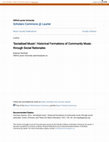
This article traces the formation of community music through professional and scholarly articles ... more This article traces the formation of community music through professional and scholarly articles over the last century in North America, and argues that community music has been discursively formed through social rationales, although the specific rationales have shifted. The author employs an archaeological framework inspired by Michel Foucault to analyze the usage and contexts of the term ‘community music’ in four historical moments, including Progressive-Era manuals and guidebooks, mid-century articles in the Music Educators’ Journal, writings of the Community Music Activity Commission established by the International Society of Music Education from 1982, and articles in the International Journal of Community Music. The author concludes that community music’s social rationales have discursively produced a social rationality, which has largely overdetermined community music as an educational enterprise, while historically underdetermining what specifically constitutes the ‘communit...
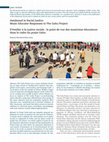
Canadian Music Educator / Musicien Educateur au Canada, 2021
The Gahu Project was a music initiative involving six high schools in Southwestern Ontario th... more The Gahu Project was a music initiative involving six high schools in Southwestern Ontario that integrated racial justice conversations and learning Gahu, a social dance of the Ewe people of Ghana. Within a larger research study that investigated impacts of the Gahu Project on creating more racially inclusive school climates, we focus on impacts of The Gahu Project on participating music educators, using data collected from a focus group of five music educators and one community organizer. Most educators were considering how to decentre whiteness in their classrooms, and many had taken actions to decentre whiteness in classroom space, curriculum, and pedagogy, with some tensions around cultural appropriation. [ABSTRACT FROM AUTHOR]
Abstract (French):
Le Projet Gahu était une initiative musicale impliquant six écoles secondaires du sud-ouest de l'Ontario. Le projet visait à stimuler des conversations sur la justice raciale et à apprendre le Gahu, soit une danse sociale du peuple Ewe du Ghana. Cet article explore le point de vue des musiciens éducateurs à propos de leur participation au Projet Gahu avec leurs élèves. Les musiciens éducateurs se sont penché sérieusement sur le fonctionnement de leur classe et des écoles en général. Notamment, ils ont réalisé que leurs exemples musicaux ne portaient que sur des compositeurs blancs et ils se sont interrogés à propos de l'appropriation culturelle en remettant en question le modèle traditionnel de « l'enseignant sur le podium ». Somme toute, ils ont commencé à réfléchir davantage à la création de classes plus inclusives sur le plan culturel.
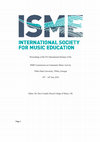
Dewey Number: 780.7 ©International Society for Music Education 2018 www.isme.org Development was ... more Dewey Number: 780.7 ©International Society for Music Education 2018 www.isme.org Development was brilliant and we thank them for their support along the pathway we made to create the gathering. We hope that these proceedings reflect the days spent talking, sharing and singing in Tbilisi. • Dr. Mary Cohen, US (Chair) • Pete Moser, UK (Chair) We believe that everyone has the right and ability to make, create, and enjoy their own music. We believe that active music-making should be encouraged and supported at all ages and at all levels of society. Community Music activities do more than involve participants in music-making; they provide opportunities to construct personal and communal expressions of artistic, social, political, and cultural concerns. Community Music activities do more than pursue musical excellence and innovation; they can contribute to the development of economic regeneration and can enhance the quality of life for communities and contribute to economic regeneration.
Movement For Canadian Literacy, Mar 1, 2009
Research associates Deanna Yerichuk and Nick Murray-Smith completed a phenomenal number of interv... more Research associates Deanna Yerichuk and Nick Murray-Smith completed a phenomenal number of interviews within a very short timeline. Their persistence and good humour made it possible to finish this research project efficiently, and gave it added depth and insight. Finally, thanks to Lindsay Kennedy of the Movement for Canadian Literacy (MCL) for her support and guidance during the process.

Policy Directions for Community Music: Looking Back, Looking Forward
This article offers an overview of public policy and community music as presented by an internati... more This article offers an overview of public policy and community music as presented by an international panel in a symposium held in Edinburgh at the XV Community Music Activity (CMA) Seminar in 2016. This article summarizes public policy in eight countries: Australia, Japan, Germany, Britain, Ireland, United States, Canada, and Brazil. As a first discussion of policy and community music, this article provides an initial gathering of preliminary information to engage the larger CM community in discussions on policy that affects how community music activities happen across the globe. This publication captures the key highlights from our XV Community Music Activity (CMA) Seminar. From 19-23 July 2016 we celebrated and explored the vibrant music-making practices, pedagogies, and cultural politics that are currently shaping community music throughout the world. The seminar brought together an amazing group of delegates from Aotearoa New Zealand, Australia, Brazil, Canada, Germany, Ireland...
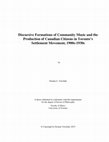
This thesis examines the discursive formations of community music through the history of Toronto’... more This thesis examines the discursive formations of community music through the history of Toronto’s settlement house movement, from the opening of University Settlement House in 1910 to the onset of World War Two. Settlement houses created community-based educational and leisure programs for poor and immigrant residents with the objective of citizenship training, and music permeated settlement work, including the establishment of Canada’s first community music schools. Settlement organizers reconfigured music not as an end in itself, but as a tool in fostering ‘civic betterment’ of poor, working class, and immigrant neighborhoods. Using primarily Foucaultian archaeological methods, this study examines how settlement music practices contributed to the discursive formation of community music with two central arguments: first, the ways in which settlement organizers used and described music through its social purpose contributed to the discursive production of community music through an...
Examining Equity in Tenure Processes at Higher Education Music Programs: An Institutional Ethnography
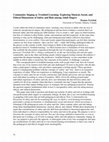
I work within the field of community music, teaching voice lessons to adults who are new or relat... more I work within the field of community music, teaching voice lessons to adults who are new or relatively inexperienced singers. My pedagogical aim has been to balance a tension that I see between safety and risk among my adult learners: I try to create a ‘safe’ space in which learners feel free of violation to their bodies, minds, and emotions and feel respected. At the same time, learning to sing can be challenging, often provoking personal and/or collective discomfort, disorientation, or even conflict. I have previously argued that participants can feel their learning contexts are free from violation—they can feel ‘safe’—while still feeling challenged either by the process or the content or both. I have begun to think of this pedagogical tension as a productive kind of “troubled learning,” in which learners have a foundation of trust and respect that scaffolds the discomfort experienced through the risk of exploring new content and processes (Yerichuk 2011). Along a continuum of, on...
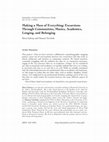
Artists' StatementThis project-what we have termed a collaborative autoethnographic mapping p... more Artists' StatementThis project-what we have termed a collaborative autoethnographic mapping project-grew out of conversations between two researchers who also work as choral conductors and teachers in community contexts. We found ourselves constantly struggling with the stubborn fact that we, as community musicians, engage in the very practices that we, as academics, critique. As we considered our roles as musicians and academics, we quickly realized that who we are is deeply entwined with where we are and who we are with. While we initially considered only the relationship between our professional roles as academics and musicians, we also began to realize that our other roles, such as mother, daughter, friend, citizen, were implicated in our professional identities, making a mess of the very idea that we could resolve the tensions between the many different aspects of our lives.Out of those initial conversations, we launched a very personal research project that explored these ...
What constitutes the 'community' of a community choir? The 'community' aspect of community choirs... more What constitutes the 'community' of a community choir? The 'community' aspect of community choirs often normatively evokes warm and positive assumptions: community singing breaks down barriers, celebrates diversity, raises alternative voices. These assumptions suggest that
Throughout the 1930s, Toronto’s social settlement houses hosted various musical performances by a... more Throughout the 1930s, Toronto’s social settlement houses hosted various musical performances by and for the immigrant and working-class residents of Toronto’s poorest neighbourhoods. Given their overarching project of civic betterment, the performances became sites not only to validate the social success of musical work, but also to enact musically notions of citizenship. Within the settlement music schools, benefit concerts and pupil recitals featured conservatory-style music performances, which articulated Western European Art Music to an Anglo-Celtic Protestant norm for citizenship. However, annual spring festivals shifted notions of citizenship somewhat by celebrating the various cultures of immigrants through music and dance.
A Scoping Review of Music Therapy in the Lives of Children and Youth With Disabilities and Chronic Conditions in Non-Acute Medical and Community-Based Settings: A Novel Consideration for Art Therapists? (Étude de portée de la musicothérapie dans la vie des enfants et des jeunes ayant des incapaci...
Canadian Journal of Art Therapy
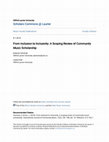
International Journal of Community Music
This article investigates how community music scholarship has taken up inclusion. Using a modifie... more This article investigates how community music scholarship has taken up inclusion. Using a modified scoping review methodology, the authors analysed 47 articles published in the International Journal of Community Music from 2008 to 2018, examining how scholars have defined and operationalized the terms 'inclusion' and 'inclusivity', which were used interchangeably in the literature. The authors found that inclusion was often normatively invoked with no definition or approaches provided. In those articles that provided more detail about inclusion, many focused on musical access, such as removing auditions and not requiring previous music skill or knowledge, and processes of musical inclusion, such as creating a friendly and non-judgmental atmosphere, providing multiple ways of engaging with music-making and cultivating musical leadership among participants. Less frequent in the literature were ideas and approaches focusing on social inclusion through music, including frameworks that aimed to address and change systems that create marginalization; approaches that addressed social barriers to participation, such as transportation and childcare; and approaches that decentralized leadership to create collective responsibility and participation. The authors conclude by examining approaches from other scholarly disciplines, arguing that community music scholarship may benefit for more sustained and deliberate use of the term inclusivity, which points to the ongoing practice and effort towards inclusion. Running head: FROM INCLUSION TO INCLUSIVITY 2 Keywords inclusion inclusivity community music literature review social inclusion inclusive education Many scholars assert that inclusion is a cornerstone of community music practice (Higgins and Willingham 2017), usually predicated on the widely circulating idea that everyone has a right to make music (Veblen and Olsson 2002), which we, the authors, also believe. However, despite a noticeable groundswell in using the terms 'inclusion' and 'inclusivity' in relation to community music over the last five years, there has been very little analysis of what these terms mean, nor how they areor should beoperationalized in community music settings. This article represents our attempt to address the gap in the literature by first focusing on how community music scholars have been defining and using inclusion in research. The two of us began this research project when we realized that each of us had concerns about normative uses of inclusion in the Community Music scholarship that we were reading. Deanna had previously raised concerns about the normative uses of the term 'community' (Yerichuk 2014), in which the community is often already assumed and seen as always and only positive without much critical reflection of the social relations that constitute the social space, or the role of the facilitator in setting terms for Running head: FROM INCLUSION TO INCLUSIVITY 3 participation in that community. Justis, through his course work, began to notice that the term 'inclusion' seemed to be used in a passive sense in community music scholarship in which inclusion was described as a fait accompli rather than understood as an active continuing effort. However, with the growth of community music scholarship in the past five years, we both wanted to dig underneath our initial impressions and investigate just how inclusion has been written about and operationalized in community music scholarship. In collaboratively analysing community music scholarship, our hope is to identify how community music scholars have been defining and using the terms 'inclusion' and 'inclusivity', and in so doing, identify both gaps and possibilities for developing inclusion in theory and in practice within community music. Methods Our central concern focuses on how community music scholars have defined inclusion, and specific approaches that operationalized inclusion in community music. We therefore conducted a literature review based on scoping review methodology (Arksey and O'Malley 2005; Levac et al. 2010), which endeavours to map literature rapidly within a defined research area. Levac et al. (2010) describe five stages to scoping reviews that we briefly describe below, including the following: (1) defining the research question; (2) identifying relevant studies; (3) selecting studies to include; (4) charting the data; and (5) collating, summarizing and reporting. While we undertook all of these steps in our research, we narrowed our focus to look through ten years of issues published by the International Journal of Community Music, a more limited focus than most scoping reviews. However, given the specific focus of our question on the scholarly field of community music and the prominent role of the journal in publishing scholarship within Running head: FROM INCLUSION TO INCLUSIVITY
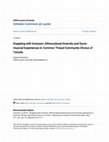
International Journal of Community Music
This pilot research study explored ethnocultural backgrounds of choristers and their socio-musica... more This pilot research study explored ethnocultural backgrounds of choristers and their socio-musical experiences participating in Common Thread Community Chorus of Toronto, a community choir that actively pursues cultural inclusion through policies of musical and financial accessibility, as well as choosing repertoire of diverse cultures. A survey of choristers investigated how Common Thread members' ethnocultural backgrounds informed their perceptions of their musical and social experiences and of the choir's cultural diversity, working from the assumption that all people have ethnocultural backgrounds. Research findings reveal complex and diverse cultures when singers reflect on their own experiences, but choristers tended to reduce cultural diversity to race and language when thinking about the choir as a whole, suggesting that perceptions may be operating from a white normative centre. The results of this pilot research raise significant questions about multicultural education and cultural inclusion efforts within community choral practices in ethnically diverse urban environments.
Intersections: Canadian Journal of Music, 2015
This study provides a snapshot of tenure at Canadian post-secondary music institutions, with a pa... more This study provides a snapshot of tenure at Canadian post-secondary music institutions, with a particular focus on gender and race/ethnicity. The data show tenure has been granted at high rates over a five-year period, and that women are no more or less likely to achieve tenure than men. However, more men than women hold both tenured and tenure-track positions, at a ratio of 2:1. The sample size of non-white faculty was not large enough to conduct statistical analyses about tenure rates in relation to race/ethnicity, although the extremely low rates of non-white tenure-track faculty suggest that diversity remains a concern in post-secondary music programs.
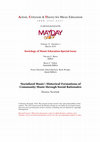
Action Criticism and Theory For Music Education, Mar 1, 2014
This article traces the formation of community music through professional and scholarly articles ... more This article traces the formation of community music through professional and scholarly articles over the last century in North America, and argues that community music has been discursively formed through social rationales, although the specific rationales have shifted. The author employs an archaeological framework inspired by Michel Foucault to analyze the usage and contexts of the term 'community music' in four historical moments, including Progressive-Era manuals and guidebooks, mid-century articles in the Music Educators' Journal, writings of the Community Music Activity Commission established by the International Society of Music Education from 1982, and articles in the International Journal of Community Music. The author concludes that community music's social rationales have discursively produced a social rationality, which has largely overdetermined community music as an educational enterprise, while historically underdetermining what specifically constitutes the 'community' of community music.
Mapping tensions between academic and community identities: A collaborative auto-ethnography of two musical lives
Engaging contemporary ideas of community music through historical sociology

Uploads
Papers by Deanna Yerichuk
Abstract (French):
Le Projet Gahu était une initiative musicale impliquant six écoles secondaires du sud-ouest de l'Ontario. Le projet visait à stimuler des conversations sur la justice raciale et à apprendre le Gahu, soit une danse sociale du peuple Ewe du Ghana. Cet article explore le point de vue des musiciens éducateurs à propos de leur participation au Projet Gahu avec leurs élèves. Les musiciens éducateurs se sont penché sérieusement sur le fonctionnement de leur classe et des écoles en général. Notamment, ils ont réalisé que leurs exemples musicaux ne portaient que sur des compositeurs blancs et ils se sont interrogés à propos de l'appropriation culturelle en remettant en question le modèle traditionnel de « l'enseignant sur le podium ». Somme toute, ils ont commencé à réfléchir davantage à la création de classes plus inclusives sur le plan culturel.